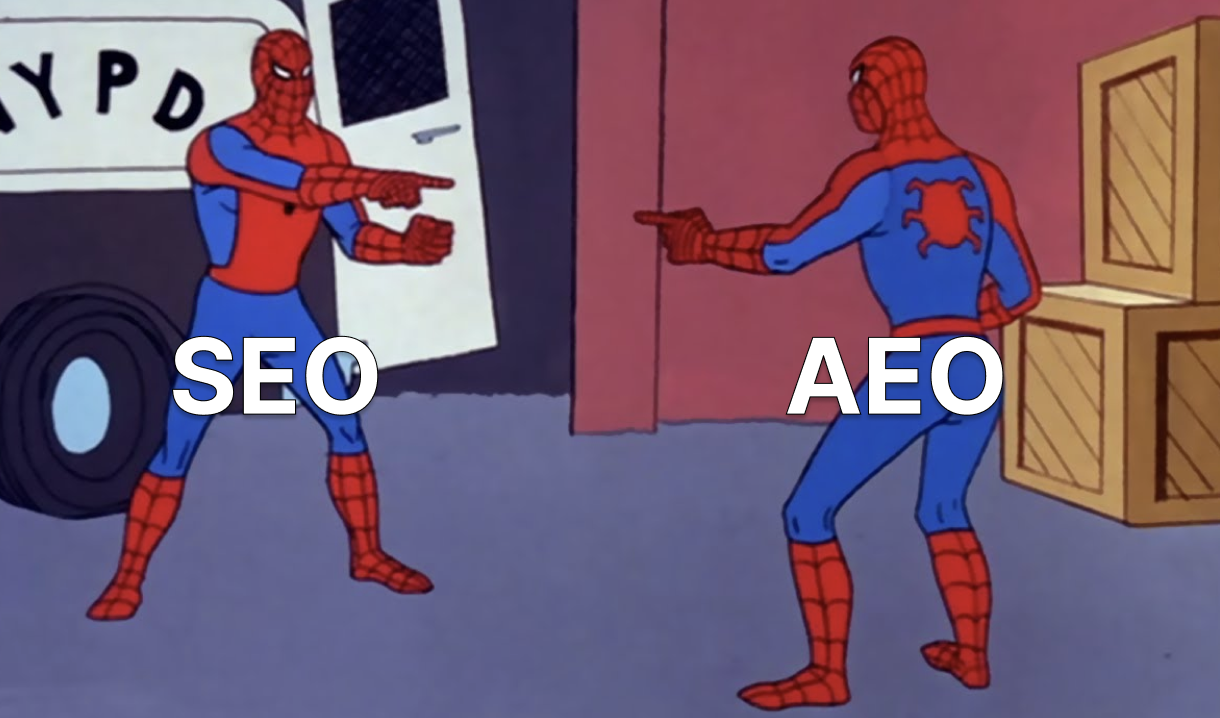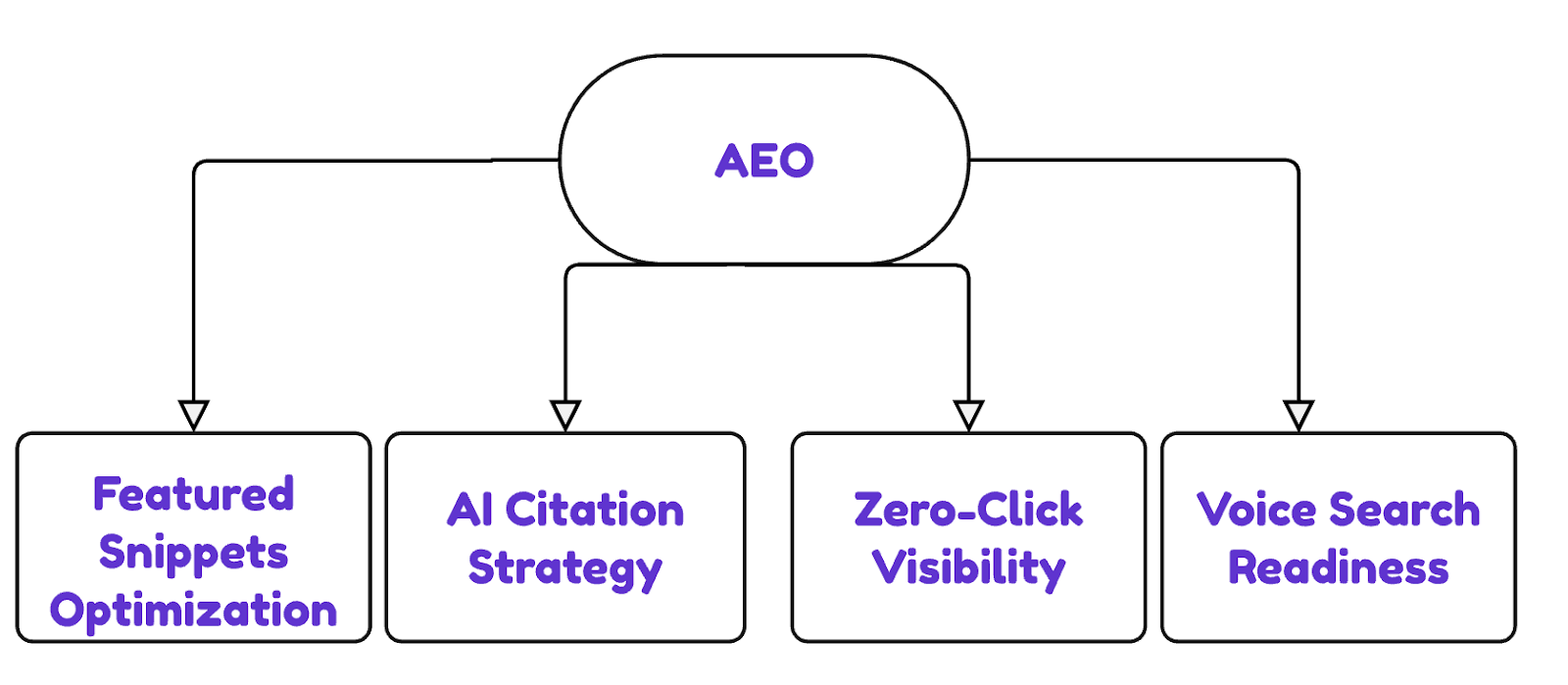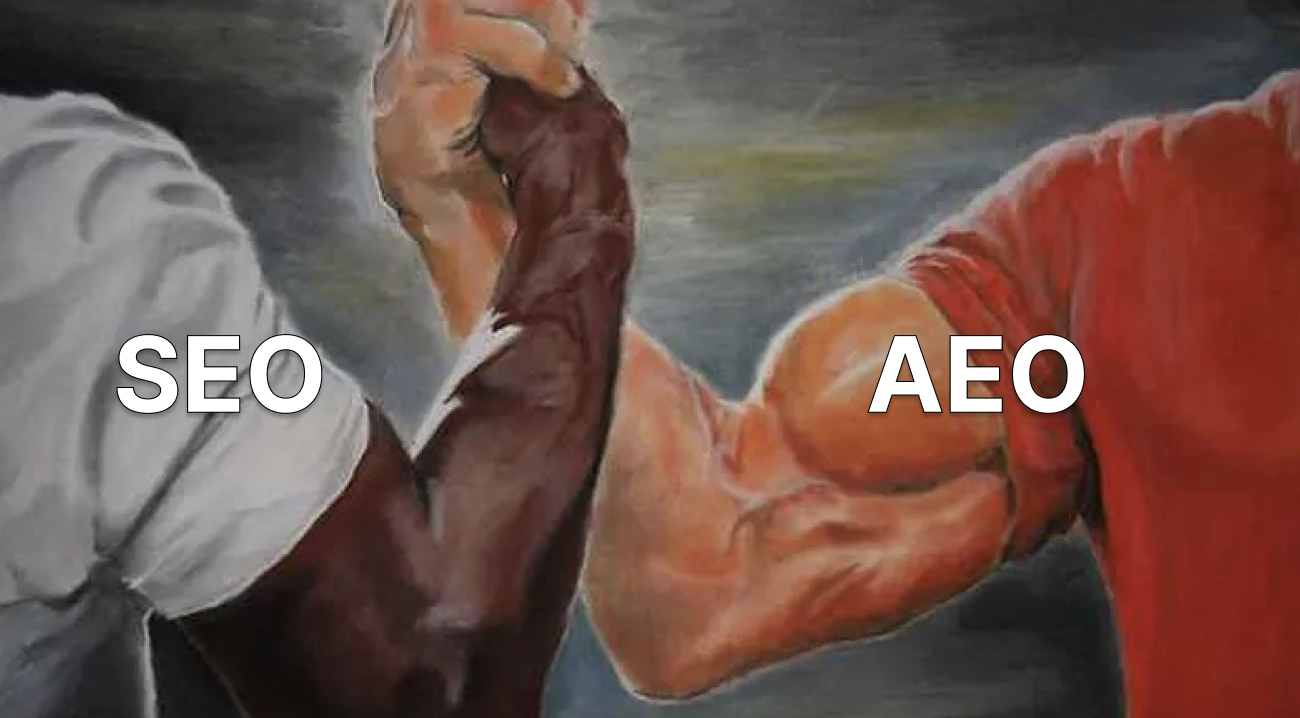Key Takeaways
The SEO landscape has reached a tipping point.
About 60% of searches today end without any click to a website, and for mobile users, that number climbs to an astonishing 77%!
Is it not just these statistics—if you are a SaaS marketer in 2025 searching for something, you most likely range from considering to fully preferring answer engines.
AI-powered platforms like ChatGPT have revolutionized how people discover information. Even outside these LLMs, search platforms are providing immediate, comprehensive responses directly on the search results page.

SaaS marketing teams face a tricky situation today: ranking well might actually mean fewer clicks.
Yet, this doesn't spell doom for search-based marketing—it just demands a new approach. The strategy should just evolve from only driving visitors to your site to appearing wherever users find their answers.
In light of these developments, Answer Engine Optimization (AEO) has emerged as the strategy that focuses on making your content the answer that engines deliver to users.
But, does it go hand-in-hand with SEO? Are AEO and SEO brothers from another mother, or should we rather focus on just one of them? First of all, how exactly are they different?

This guide answers these questions, and much more. Read on.
What is Answer Engine Optimization (AEO)?
Here’s how CXL defines AEO:
The practice of optimizing your content so that search platforms can directly provide answers to user queries, rather than just listing links. It focuses on making your content the answer that engines deliver to users, whether through featured snippets, voice assistant responses, or AI-powered chat results.
Unlike traditional search engine optimization, AEO evolved from the recognition that search has transformed from a discovery process to an answer-delivery system. This evolution reflects a broader change in user behavior and tech capabilities.
Four Essential Components of AEO

At its core, AEO is a combination of these factors that work together to maximize visibility in AI-powered responses:
Featured Snippets Optimization: Targets position zero—that coveted spot above traditional search results, which displays direct answers.
AI Citation Strategy: Focuses on implementing structured data that LLMs can easily consume and reference.
Zero-Click Visibility: Ensures your brand maintains presence even when users never click through to your website.
Voice Search Readiness: Addresses the growing trend of conversational queries, recognizing that voice queries tend to be longer and more specific than text searches.
What is Search Engine Optimization (SEO)?
SaaS SEO is the practice of optimizing SaaS websites to increase organic traffic, generate leads, and drive conversions from search engines such as Google or Bing. SEO remains the bedrock of digital visibility.
Search Engine Optimization is built on principles that have evolved over decades but remain fundamentally important: At its heart, SEO operates within Google's E-E-A-T framework—Experience, Expertise, Authoritativeness, and Trustworthiness.
The Three Core Pillars of SEO

The foundation of SEO rests on three core pillars that work synergistically:
On-page optimization: This is about content quality, keyword targeting, and meta tag optimization—the elements you control directly on your website. This includes crafting compelling title tags, writing informative meta descriptions, and ensuring your content thoroughly addresses user intent while incorporating relevant keywords naturally.
Off-page SEO: This extends your influence beyond your website through link building, brand mentions, and domain authority development. Every quality backlink acts as a vote of confidence, while brand mentions across the web reinforce your authority in your field.
Technical SEO: This ensures search engines can effectively crawl, understand, and index your content. This includes optimizing site speed, ensuring mobile responsiveness, and maintaining a clean, crawlable site structure.
Both SEO and AEO emphasise common core values surrounding the usefulness of the information. At the end of the day, if your content doesn’t provide any value, it is unlikely to get picked up by both search engines and answer engines!
AEO vs SEO: Key Differences Explained
Understanding the distinctions between AEO and SEO reveals not competing strategies but complementary approaches designed for different aspects of modern search.
It is, therefore, not surprising that some of the points under SEO, such as technical optimisation, also apply to AEO.
Putting it simply: SEO aims to drive website traffic through high rankings, measuring success through clicks, time on site, and conversions. AEO seeks visibility in AI-generated responses.
Content Differences
SEO favors comprehensive coverage with strategic keyword density, creating in-depth resources that establish topical authority. AEO demands direct answers using conversational language.
But here’s the thing: As a SaaS marketer, you can’t really create separate content pieces for SEO and AEO. The approach is to incorporate both SEO and AEO fundamentals into the same content effort.
A point to note about AEO: AI overviews are more TOFU-focused than MOFU and BOFU, and answer-engine queries are typically more long-tail.
We’ll cover more on this topic in the upcoming sections.
Success Tracking
Rather than focusing on traffic volume, AEO success centers on visibility metrics that reflect brand presence across AI-powered platforms.
- Featured snippet tracking becomes crucial as these position-zero placements directly feed AI responses.
- Brand impression data reveals how often your content surfaces in search results, even when users don't click through.
- Share of voice calculations provide competitive context, revealing how your brand's AI visibility compares to industry leaders.
Success in AI-powered search often means users never visit your website—yet still discover, trust, and ultimately choose your brand. The challenge lies in connecting AI exposure to business outcomes when users no longer follow predictable click-through patterns.
Technical Focus
Traditional SEO technical optimization centers on foundational elements: page speed optimization, mobile-first indexing, and clean site architecture with logical URL structures. Technical SEO audits focus on resolving crawl errors, duplicate content issues, and indexation problems that prevent effective ranking.
While these things matter to AEO as well, it demands more attention to schema markup. The most effective schemas for AEO include:
- FAQPage Schema structures Q&A content for easy AI consumption
- HowTo Schema makes step-by-step guides accessible to answer engines
- Product Schema ensures e-commerce offerings appear in both traditional product searches and AI-powered shopping recommendations.
- LocalBusiness Schema captures local intent across traditional queries and voice-driven requests.
This structured data acts as a translation layer between human-readable content and AI systems, enabling accurate information extraction and citation.
AEO vs SEO: Which Strategy Should You Choose?
The question of choosing between AEO and SEO reveals a false dichotomy, because it is not an “either/or” discussion but an “and” discussion.

If your page isn't in the top results, it's much less likely to be included in the AI answer. In fact, an Ahrefs study reveals that 76% of AI Overview citations are from the Top 10 results.
This data point crystallizes a crucial reality: SEO lays the groundwork for AEO.
The lines between these strategies blur further as search engines themselves evolve into answer engines. Google steadily provides more direct answers via featured snippets, Knowledge Graph panels, and now, generative AI summaries. Bing has followed suit with its AI integration.
Which is all to say that: When you optimize for Google Search, you're simultaneously optimizing for Google's AI answers.
How to Implement AEO and SEO Together
Creating an integrated optimization strategy requires a systematic approach that utilizes the strengths of both SEO and AEO.
The implementation framework begins with a unified content architecture that serves both traditional search and AI platforms effectively.
The Hub-and-Spoke Content Model
This provides an ideal structure for building topical authority while helping AI’s understanding.
Central hub pages offer comprehensive coverage of core topics, satisfying SEO's need for depth and authority. Surrounding spoke content addresses specific questions and subtopics in the concise, direct format that AEO demands.
Organizing content around the actual queries users pose to both search engines and AI assistants can be very useful, as semantic content relationships tie everything together.
Technical Foundation
Technical implementation requires a unified approach that serves both traditional search crawlers and AI systems simultaneously.
The foundation begins with schema markup implementation, using Google Search Central and Schema.org guidelines to create structured data that benefits both optimization approaches.
Schema markup becomes the bridge between SEO and AEO success, with specific types serving dual purposes. Beyond schema, the technical architecture must support both crawling patterns.
Site speed optimization benefits SEO rankings while ensuring AI systems can efficiently process content. Clean URL structures and logical hierarchies help search engines index effectively while providing AI systems with clear content relationships for better context understanding.
Content Optimization
For SEO purposes, maintain long-form, comprehensive coverage that establishes expertise and authority.
Within this same content, incorporate concise answers of 40-60 words upfront—these snippets serve AEO by providing clear, direct responses that AI systems can extract.
Both strategies benefit from clear heading structures using H2 and H3 tags, which help organize information logically.
Natural language patterns throughout support voice optimization, ensuring your content matches how people actually speak when asking questions.
Measuring Success
Traditional SEO metrics—rankings, traffic, and conversions—remain important but tell only part of the story.
AEO metrics like featured snippet ownership and AI citations require equal attention.
Creating a unified reporting system that captures brand visibility scores across all channels provides the complete picture.
Tools like Profound for AI tracking complement traditional SEO platforms, enabling monitoring of featured snippet performance, AI citation frequency, and brand impression value in zero-click environments.
The attribution challenges in zero-click searches require new thinking about value creation and measurement, moving beyond simple last-click attribution to understand the full impact of visibility across all search experiences.
AEO vs SEO: Industry-Specific Applications
Industry context shapes the optimal balance between AEO and SEO strategies, with each sector requiring distinct resource allocation and tactical emphasis based on user behavior and regulatory requirements.
B2B SaaS companies should prioritize AEO for comparison and evaluation content while maintaining SEO for product documentation. For B2B SaaS businesses, AEO positions them as reliable information sources, helping to build brand authority and trust. The strategic focus involves emphasizing AEO-friendly comparison matrices and "versus" content that buyers actively research, while maintaining traditional SEO for detailed feature pages that require deeper exploration and conversion optimization.
E-commerce businesses face a balancing act, requiring investment in both approaches for different stages of the customer journey. SEO remains essential for product discovery and category pages, while AEO captures users seeking quick product comparisons and specifications. Product comparison tables and detailed specifications become crucial, as AI systems frequently reference this structured information when answering shopping queries about features, pricing, and availability.
Local businesses should emphasize AEO given the conversational nature of local searches. Voice optimization and LocalBusiness schema capture the majority of location-based queries, while traditional SEO supports broader geographic visibility. With many consumers using voice search to find local businesses, optimizing for voice search can really enhance local SEO and drive more traffic.
Healthcare companies require a careful balance due to compliance. While AEO helps capture health-related questions, medical content requires attention to accuracy and appropriate disclaimers, as AI systems prioritize credible sources where health information directly impacts patient safety.
Finance companies must balance quick financial information delivery through AEO with comprehensive guidance through traditional SEO. AI engines often favor content that reflects the most up-to-date information - especially in industries like tech, health, and finance. Regulatory requirements often demand extensive context and compliance documentation that works better in traditional SEO formats than concise AEO responses.
Future of Search: AEO and SEO in 2025 and Beyond
The trajectory of search technology points toward an increasingly integrated future where the boundaries between different types of optimization continue to blur.
Multimodal Search and AI Integration
Multimodal search optimization represents the next frontier, combining text, voice, and visual inputs in single queries.
This evolution demands content strategies that work across all modalities. AI API integrations for direct submissions suggest a future where businesses can provide information to AI platforms rather than waiting to be crawled and indexed.
Personalized AI responses based on user history will create unique optimization challenges, requiring content that adapts to different contexts and user needs.
Cross-platform optimization strategies must account for AI assistants across devices and platforms.
Preparing for the Evolving Landscape
Focus on building robust foundations that can adapt to change:
- Develop authoritative content libraries so that you have resources that AI systems can reference
- Invest in structured data infrastructure to create the technical backbone for future visibility
- Create AI-friendly content formats—clear, concise, well-structured information. This positions your content for success regardless of how search technology evolves
- Monitor AI visibility metrics alongside traditional measures to catch early signals of changing user behavior and platform preferences
Long-term Planning and Investment
The transition from traffic to brand visibility metrics reflects the reality that value creation extends beyond website visits.
Investment in AEO capabilities—including tools, training, and processes—prepares organizations for a future where AI mediation may become the norm.
Content strategy must evolve to serve both human readers and AI consumption, creating materials that work effectively in both contexts.
Partnership opportunities with AI platforms may emerge, offering new ways to ensure visibility and accuracy in AI-generated responses.
Conclusion
The journey through AEO and SEO reveals not competing philosophies but complementary strategies essential for modern digital success.
The key point is this: AEO and SEO work together synergistically, not against each other.
Start with one comprehensively AEO-optimized piece that can serve as a model for future content. Begin tracking AI visibility alongside traditional metrics to understand your true digital footprint. These first steps set the foundation for thriving in an evolving search landscape where success means being found wherever and however your audience seeks answers.
TripleDart specializes in helping B2B SaaS companies with their SEO and AEO strategies. We’ve helped several companies find their footing with ranking in AI as well as search engines at the same time, helping them ace the AI era of search.
If you want to see how TripleDart's services can help you improve your organic revenue, book a call and let’s talk!
Frequently Asked Questions (FAQs)
What is the main difference between AEO and SEO?
SEO aims to drive website traffic through high rankings in search results, measuring success through clicks, time on site, and conversions. AEO seeks visibility in AI-generated responses and direct answers, focusing on making your content the answer that engines deliver to users without requiring clicks to your website.
Is AEO replacing SEO in 2025?
No, AEO and SEO work together synergistically rather than competing against each other. Strong SEO—achieving high search rankings—lays the essential groundwork for AEO success, with 46% of sources cited in Google's AI Overviews coming from the top 10 organic search results.
How do I optimize content for both AEO and SEO?
Maintain long-form, comprehensive coverage that establishes expertise and authority for SEO purposes, while incorporating concise answers of 40-60 words upfront that AI systems can extract for AEO. Use the hub-and-spoke content model where central hub pages satisfy SEO's need for depth while surrounding spoke content addresses specific questions in the direct format that AEO demands.
What are the main benefits of AEO?
AEO ensures your brand maintains presence even when users never click through to your website, helping you appear wherever users find their answers in an era where 60% of searches end without clicks. It positions businesses as reliable information sources, building brand authority and trust while capturing the growing segment of conversational and voice searches.
Which businesses should prioritize AEO?
Every business with a digital presence should prioritize AEO in 2025, as the shift toward AI-powered search affects all industries and user behaviors. B2B SaaS companies, local businesses, and e-commerce operations see the most immediate benefits, with SaaS companies excelling at comparison content, local businesses capturing conversational searches, and e-commerce brands addressing quick product inquiries through AI responses.
How do I measure AEO success?
AEO success centers on visibility metrics rather than traffic volume, including featured snippet tracking, brand impression data, and share of voice calculations that reveal how your brand's AI visibility compares to competitors. Success often means users never visit your website yet still discover, trust, and ultimately choose your brand, requiring new measurement approaches that move beyond simple click-through attribution.
Related Posts
We'd Love to Work with You!
Join 70+ successful B2B SaaS companies on the path to achieving T2D3 with our SaaS marketing services.

.png)
.png)



%20Agencies%20(2025).png)
![Top 11 AI SEO Content Generators for 2025 [Ranked & Reviewed]](https://cdn.prod.website-files.com/632b673b055f4310bdb8637d/6858e2c2d1f91a0c0a48811a_ai%20seo%20content%20generator.webp)


